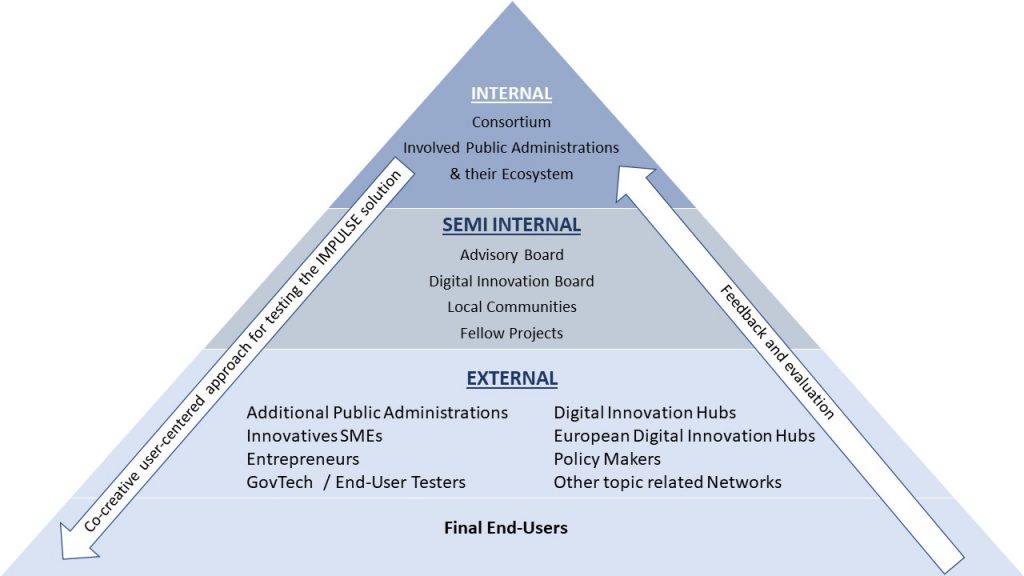by Diana Silvestru – Agency for European Integration and Economic Development
The end user represents a person for whom a hardware or software product is designed. In IMPULSE, potential final end users become an active part of the development of the innovative eID solution.
The range of stakeholder in IMPULSE
IMPULSE focuses on combining two of the most promising technologies available today: Artificial Intelligence and Blockchain networks. We are creating an eID platform that will allow individual citizens or legal representatives of companies to use the camera of their mobile device as a mechanism for identification and authentication to access online public services.
IMPULSE explores the use of these disruptive technologies in a co-creative user-centred approach. The project is directly involving internal project participants, semi-internal representatives of the communities of our six case studies[i] or from other fellow projects as well as external stakeholders to the projects such as policy-makers all over Europe, different selected Digital Innovation Hubs (DIHs), entrepreneurs or gov-tech representatives and, last but not least, citizens as testers or final end users.

Final end users in IMPULSE
In August 2022 we have just started with the pilot phase. This means we are ready to take the first prototype of the IMPULSE solution out into the world for initial testing. The testing phase is conducted in the framework of our local case studies with various stakeholders and potential end users. Our main goal is to create the foundation for an eID solution that suits the requirements of the final end user the most. IMPULSE refers to the end user in terms of the field of information technology. So the end user represents a person for whom a hardware or software product is designed:
“We [the IMPULSE team] are referring to the ultimate consumer understood more broadly, in a more abstract way, for whom the final solution is designed and who may not be aware of the entire process extract from the project. In the sense of this evaluation, the final end users are equal to the general public.” [2]
Final end users of IMPULSE could be citizens or legal representatives of companies, who would like to access online public services using the Single Sign-On (SSO) solution created by the project. Following the demand-driven approach of IMPULSE, the final end user stands at the end of the development chain of our product. Although, involving end user tester some potential final end users become an active part of the development of the eID solution.
Information gap and coping strategies in IMPULSE
Studies in the field of technology development and awareness raising highlight an essential information gap related both to properties and features of new technologies and security issues between core developers, pool managers and final end users [1].
For IMPULSE, the question increasingly arises as to what end users want, expect and need when it comes to new self-sovereign identity (SSI) schemes [3], innovative eID solution or the online self. One of the major challenges of projects aiming at enhancing digitisation of the public sector as well as to raise awareness in relation to this topic represents the fact that users are not aware about how vulnerable they are. Some of the reasons are they use services and apps without reading their agreements or contracts in most cases [6] and, in general, do not have enough time to clearly comprehend these issues. Concepts such as the trust triangle, proof requests, data sovereignty as well as verified credentials are completely new to the user. Given their importance to understand SSI and its consequences, these points require special attention when onboarding new users [4].
IMPULSE tries to bridge these tendencies by creating a test environment through piloting workshops, round tables with policy makers, social media postings. Through these communication methods future potential end users of eID solutions in public administration systems may establish an early connection to the creation of such digital identity management solutions. When introducing a new kind of identity management to the general public, it is necessary to involve and convince both the civil society and the decision makers of the benefits of the technology [4]. In a nutshell, the whole ecosystem.
The high role of self-determination of the user
The scientific research landscape also points out other angles highlighting the high role of self-determination which user experience in shaping their digital identity and the online self:
- Users are actively searching for ways to manage and build their digital identity according to current expectations and changing digital trends [6]. It is extremely difficult to always stay informed and digitally guarded, to get a superficial understanding of the concept within a short time (ICT, cryptography, multinational law, user-experience design, standardisation etc.) [4][6].
- Users want to know who is accessing their data and for what purposes, because they want to avoid negative effects [6] and would like to have control over their own data. Against this comes the speed of technological development: devices and services are appearing and disappearing year after year while users are hunting for long-term guidelines on how to control their digital data sets [6]. SSI schemes seem to offer more autonomy, choice and transparency for the user. Nevertheless, the usage of SSI requires the user to adapt to new workflows and the additional responsibility to execute a backup strategy [4].
Accordingly, the fundamental problem of online control on the societal micro level is the limited time that users have to monitor their digital footprints [6] as well as the rapidly developing technology which requires updated specialised knowledge. When it comes to the usage and adoption of new technologies, especially those that focus on eID applications, there are also many other factors affecting end users. Some of these factors are trust and acceptance, accessibility and inclusion, perceived personal benefit coming from using a specific application, frequency of use, interoperability with other systems and applications. And the list continues…
Awareness raising in IMPULSE
Though local projects are recommended, experts and policy makers suggest the exchange of experience and lessons learned should be worldwide, taking smaller projects such as for vulnerable groups (for example elderly, people with different disabilities, people with restricted access to internet) into account since SSI and the topic eID are still comparably new [5] and difficult to understand in a rush.
The IMPULSE project is already putting wheels in motion and opening its doors in that spirit, working together with a wide range of stakeholders to raise general awareness on the issues just mentioned. We will succeed through:
- educating and training potential end-users and always pointing them in the right direction, so they do not get lost on the way;
- sharing and changing experience with fellow projects;
- communicating our results through social medial channels and on scientific platforms;
- convincing the civil society as well as decision makers and our stakeholders – in a nutshell, the whole ecosystem – of the benefits of the IMPULSE solution.
[i] City of Aarhus (Denmark): NemID card retrieval from lockers; Police Department of Ertzaintza (Spain): Online complaints service; Gijon City Council (Spain): City public services app; Municipality of Peshtera (Bulgaria): Civil registration and certification; Union Camera & Info Camere (Italy): Enterprise digital drawer; City of Reykjavik (Iceland): Better Reykjavik participatory democracy portal.
[1] Atzori, Marcella (2015): Blockchain Technology and Decentralized Governance: Is the State Still Necessary? Social Science Research Network. https://ssrn.com/abstract=2709713 (last access 2022 08 04)
[2] Auvray, Bertille; Diana, Silvestru et al. (2022): IMPULSE Deliverable D7.11 Community management, briefings and demonstrations for end users, DIHs and stakeholders. Status: public.
[3] Martin, Nicholas (2021): IMPULSE Blog on SSI schemes and the public sector: https://www.impulse-h2020.eu/2021/11/05/self-sovereign-identity-ssi-schemes-and-the-public-sector/ (last access 2022 08 04)
[4] Doerk, Adrian (2020): The growth factors of self-sovereign identity solutions in Europe. Thesis October 2020. ResearchGate DOI: 10.6084/m9.figshare.14182586.
[5] Ehrlich, Tobias; Richter, Daniel; Meisel, Michael; Anke, Jürgen (2021): Self-Sovereign Identity als Grundlage für universell einsetzbare digitale Identitäten. Springer https://doi.org/10.1365/s40702-021-00711-5 (last access 2022 08 08)
[6] Fehér, Katalin (2019): Digital identity and the online self: Footprint strategies – An exploratory and comparative research study. SAGE Journal of Information Science 1–14. https://journals.sagepub.com/doi/abs/10.1177/0165551519879702 (last access 2022 08 05)
